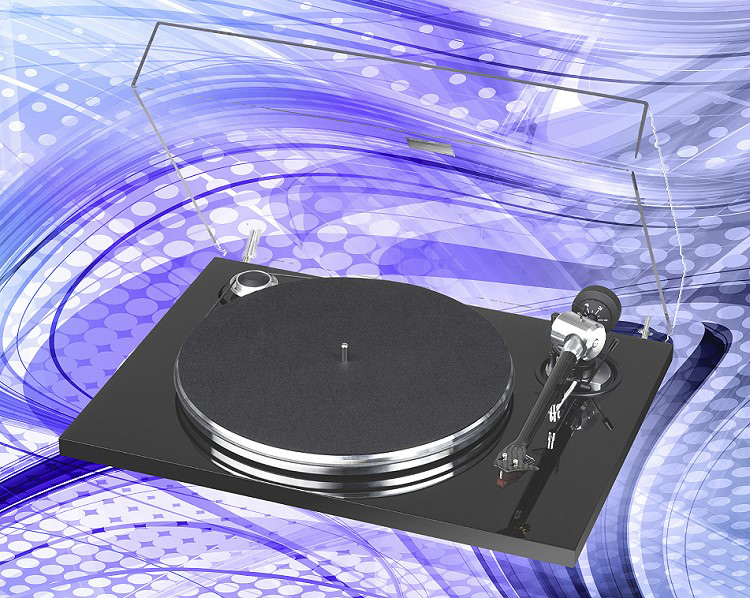For those of you out there who have not yet jumped into the vinyl resurgence, this product is for your perusal. It is priced at $1,195 USD, and it comes with a pre-installed Ortofon 2M Red cartridge. It is “ready to go”. You just plug the output jacks into a phono preamplifier, the phono preamplifier into your main preamp, and you will be listening to some vinyl.
The Prelude is designed as a product for those audiophiles who love quality sound, and who have heard some vinyl in their audio experiences, perhaps at a friend’s home, or at a HiFi show, and who want to have those experiences in their own home. The Prelude is just for you. It is not very expensive, but it has audiophile-grade quality. It’s not fancy, no walnut base (called a plinth), no $4,000 phono cartridge (but it does come with a nice one that you can use while you evaluate whether you want to really get into vinyl with both feet, and if you so decide, upgrade to a really nice phono cartridge later on).
I listened to the Prelude with my extensive LP catalog, including jazz, classical, popular, and rock. It surprised me with the excellent quality of sound for such a reasonable price. Nice clarity and detail. Instruments sounded natural.
The build quality is very good for the price too. Heavy platter, carbon fiber tonearm (this reduces resonance), low friction bearing (where the tonearm pivots).
It also bench tested very satisfactorily. The slight deviations from perfection will not be audible. They are deviations that are improved upon with higher-level turntables. It is sort of like going from a small amount of distortion to having very, very low distortion. The kind of things that audiophiles like to have, and eventually do have.
The E.A.T. Prelude Turntable is a good value and will serve the entry-level potential vinyl enthusiast well.
E.A.T. Prelude Turntable
- Excellent build quality.
- Heavy platter.
- Isolated motor.
- Pre-installed cartridge.
- Won’t break the bank.
All audiophiles are aware that vinyl has re-emerged to become a major force in music listening. However, on average, you probably have not purchased a turntable, especially if you are young.
If you are not convinced, then go to an audio dealer and sit down with your Starbucks coffee and listen to a few LPs. If you like what you hear, ask questions about what is important in deciding on a turntable. Of course, price is always a big factor. In today’s world, everything is expensive, and vinyl equipment is no exception.
You can find turntables, including the cartridge, and in some cases, a built-in phono preamplifier, for just a few hundred dollars. However, I can practically guarantee you that, should vinyl become a passion with you, that really inexpensive setup will not keep you satisfied.
So, I would suggest that you consider getting something that will be upgradable with a higher performance phono cartridge, which will perform at audiophile-quality, until if-and-when, you decide you want to jump in with all fours.
E.A.T. Prelude Turntable
Design:
Belt Drive Turntable with tonearm and cartridge
Speeds:
33 and 45 rpm via changing belt position
WOW & Flutter:
33 RPM: +/- 0.15%, 45 RPM: +/- 0.13%
Downforce Range (VTF):
0-30 mN, 0-3 gm
Tonearm Length:
230 mm
Tonearm Mass:
8 grams
Plinth:
MDF
Main Bearing:
Brass
Platter:
Aluminum Magnesium
Tonearm Design:
230 mm Carbon Conical Fiber
Arm Bearing:
Cardan Gimbal in Zircon Bowl
Motor:
AC, Isolated from Plinth
Built-In Phono Preamp:
None
Supplied Cartridge:
Ortofon 2M Red, MM
Accessories:
Dust cover, mounting hardware, counterweight, RCA cable
Colors:
Gloss Black
Dimensions (WxHxD):
462 mm x 340 mm x 110 mm
Weight:
8 kg, 17.6 lb
MSRP:
$1,195 USA with Cartridge
Ortofon 2M Red Cartridge
Design:
Moving Magnet Phono Cartridge
Stylus Tip:
Elliptical Diamond r/R 8/18 μm
Output:
5.5 mV at 5 cm/sec
Frequency Response (manufacturer):
20 Hz 0 20 kHz + 3 – 1 dB
Channel Separation (manufacturer):
22 dB @ 1 kHz
Recommended Tracking Force:
1.8 gm (18 mN), 1.6-2 gm Range (6-20 mN)
Recommended Resistance Loading:
47 kOhms
Recommended Capacitance Loading:
150-300 pF
Compliance:
Dynamic, lateral – 20 μm/mN
Weight:
7.2 grams
SECRETS Tags:
E.A.T., Ortofon, Turntables, Vinyl, Turntable Reviews, Turntable Review 2020
The E.A.T. Prelude turntable comes pre-assembled except for the counterweight and dust cover. The pointed feet are sharp, so I placed them in brass cups to protect the surface of the table underneath the feet. The included dust cover is connected to the cover mounts on the rear of the turntable. The included RCA cable which includes a ground wire is connected to the RCA phono cartridge output jacks on the rear as well.
Before placing the platter onto the plinth, I added some commercial bearing grease to the vertical spindle before that goes into a hole in the plinth.
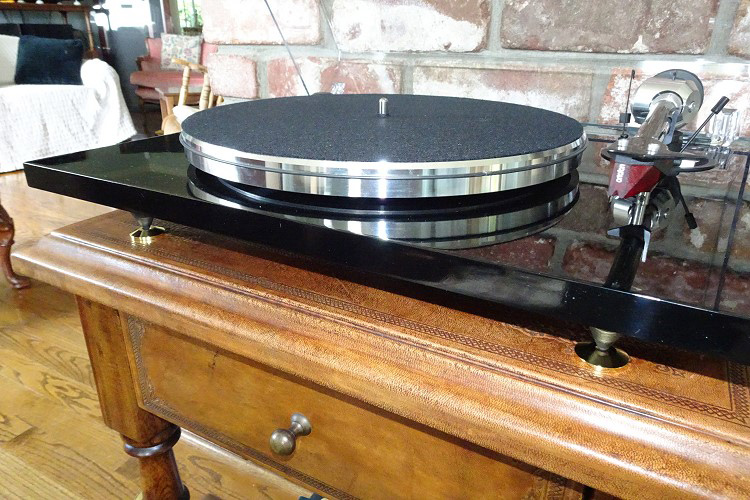
Be sure to level the turntable, using a bubble level.
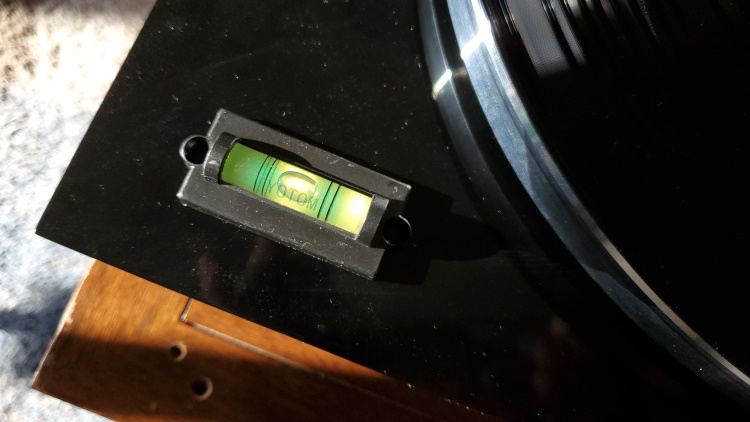
The phono cartridge has been factory-mounted and aligned, but it is a good idea to check the various alignment factors anyway. These include the Horizontal Tracking Angle (HTA), Vertical Tracking Angle (VTA), and Azimuth.
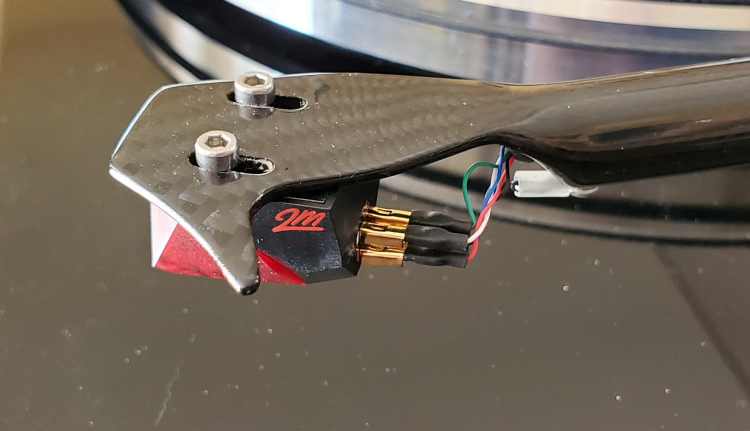
The tonearm is 9” effective length, and you can align the cartridge HTA with two-points or one-point. I chose to align it as a single point in the center between the two points in a protractor as shown below. It is just a matter of preference.
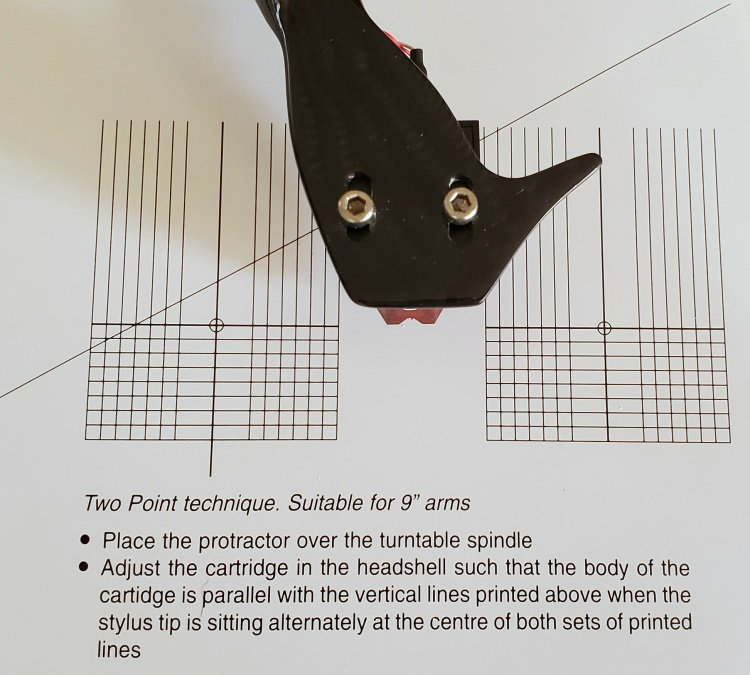
The Vertical Tracking Angle (VTA) is set by adjusting the height of the tonearm using two inset screws, one of which is pointed out by the green arrow below. I inserted a hex wrench into the screw hole for the photo. The Azimuth is adjusted with the inset screw pointed out by the red arrow (a hex wrench was inserted into that screw hole too).
The counterweight is screwed onto the rear of the tonearm (shown below), and then the phono cartridge tracking force is set using a tracking force gauge (not included). The recommended tracking force is 1.8 gm.
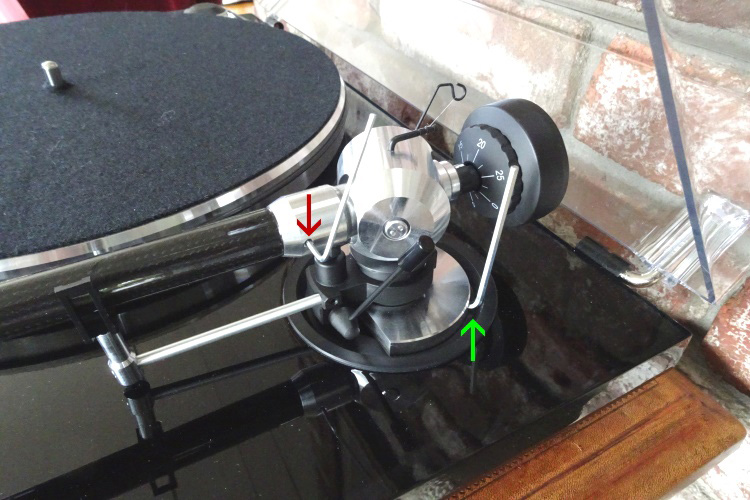
The VTA, when adjusted, will have the distance between the tonearm and the surface of the LP the same for the entire length of the tonearm.
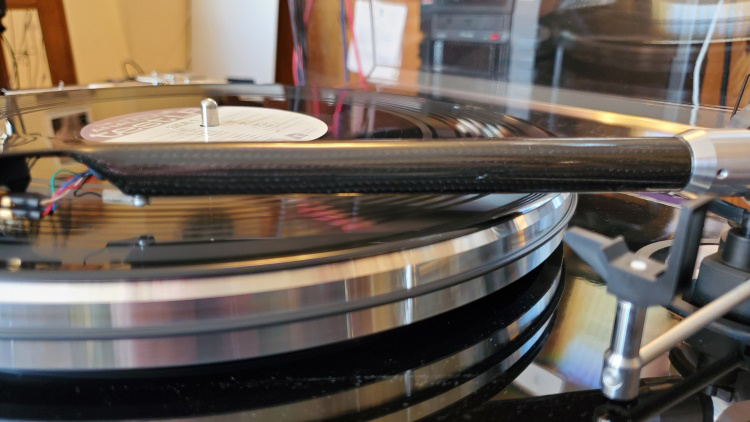
The Azimuth adjustment is used to set the cartridge so that the distance between the left bottom of the cartridge to the left of the needle and the surface of the LP, as well as the distance between the right bottom of the cartridge to the right of the needle and the surface of the LP, are equal.
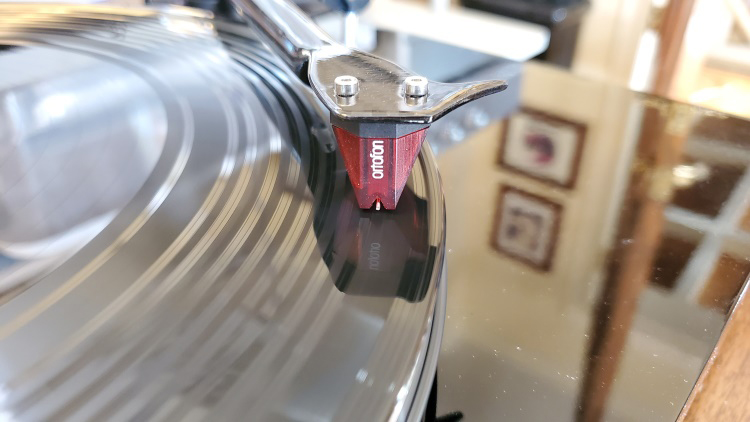
I used a tracking force gauge that I bought on Amazon for about $13. I set the tracking force at 1.84 gm.

An anti-skate weight is included, and you install it by connecting one end of the thread to the short spindle on top of the gimbal bearing, pointed out by the yellow arrow below. The thread (red arrow) is placed over a hook in a wire just to the left of the red arrow, and the weight is suspended above the plinth (green arrow).
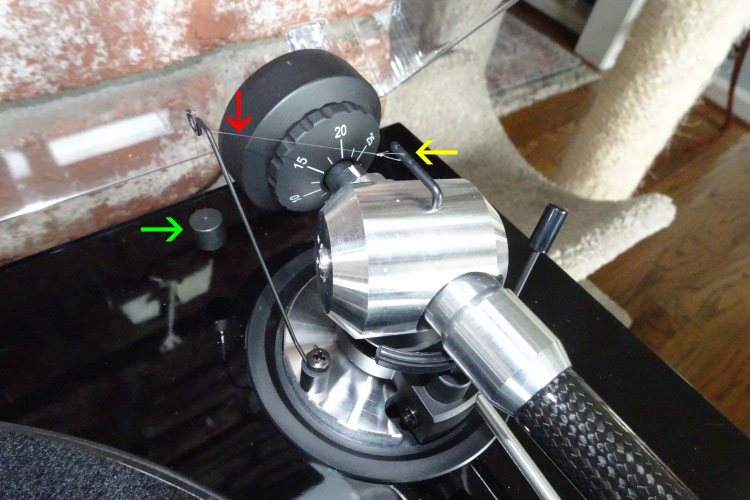
For a tracking force of 1.8 gm, the anti-skate thread is attached to the middle notch on the spindle, pointed out by the yellow arrow below.
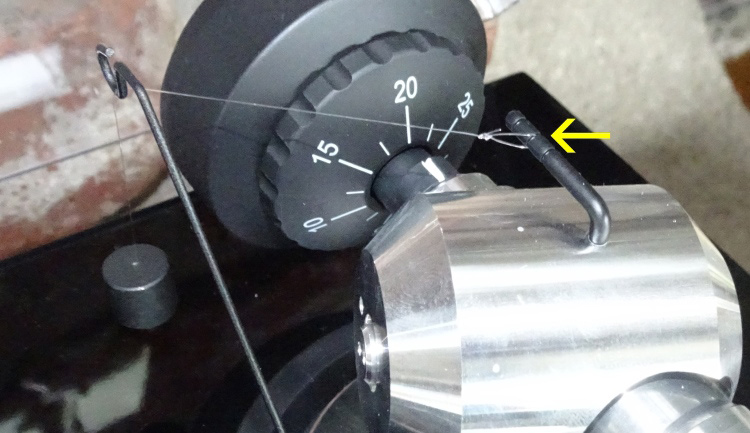
The motor is placed in a hole at the upper left corner of the plinth (shown below). The motor’s power cable is plugged into the mounting plate on the underside of the plinth, and the power supply cable is plugged into the other side of the mounting plate. The rubber belt is placed around the upper pulley (for 33-1/3 RPM LPs) and around the platter. Turn the platter for a few rotations to make sure the belt is properly aligned along the perimeter of the platter.
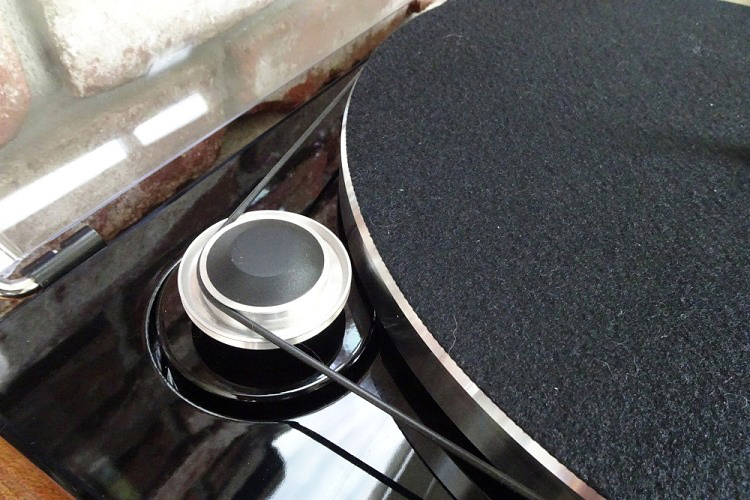
For this turntable review, I used an E.A.T. E-Glo Petit phono preamplifier with a gain of 45, 47 kOhm resistive load, and 270 pF capacitive load. Other equipment included a Pass Labs Xs Preamplifier, Pass Labs Xs 300 Power Amplifiers, and Sonus faber Lilium Speakers. Cables were Clarus Audio and Wireworld. A Clarus Concerto Power Conditioner with Crimson Power Cable was used with the E-Glo Petit phono preamplifier and Xs preamplifier.
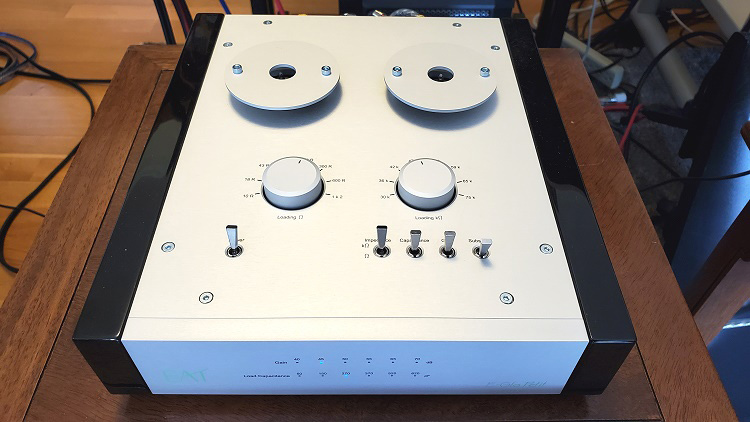
This phono preamplifier is described in detail here.
Complete List of Reference Equipment: OPPO BDP-105 Universal Player (4), OPPO UDP-205 Universal Player (2), VPI-HR-X Turntable with Sumiko Blackbird MC Cartridge and Sumiko Palo Santos MC Cartridge, Manley Labs Steelhead Tube Phono Preamplifier (2), Balanced Audio Technology VK-5i Pure Class A Triode (Tube) Stereo Preamplifier (Fully Balanced), Balanced Audio Technology VK-500 Solid State Stereo Power Amplifier (Fully Balanced) (250 Watts per Channel), Pass Labs Xs Preamplifier, Pass Labs Xs 300 Monoblock Power Amplifiers (2) (300 Watts/each), Lamm LL1 Signature Stereo Pure Class A Triode (Tube) Preamplifier, MartinLogan CLX Full-Range Electrostatic Speakers, Magnepan 20.7 Planar-Magnetic Speakers, Paradigm Reference Signature SUB 2 Subwoofers (2), Custom-Built Computer for Audio Analysis, Accupel HDG-3000 Digital Color Signal Generator (1080i capable), Component Video and DVI Output, ColorFacts Pro Video Test and Calibration Software, Version 6.0, Spyder Sensor, SpectraPlus Audio Analysis Software, Audio Precision SYS-2722 Spectrum Analyzer, Staco 3PN2210B-DVM 22 Ampere Variable Transformer (for adjusting line voltage to 120 volts during amplifier power output tests), Pass Labs XP-20 Stereo Preamplifier, Classé SSP-800 Surround Sound Processor, Emotiva XMC-1 Surround Sound Processor, Classé CA-5200 Five-Channel Power Amplifier (200 Watts per Channel), Pass Labs X600.8 Power Amplifiers (4) (600 Watts/Each), Audio Control Phase Coupled Activator (Sub-Harmonic Generator), Carver Platinum Mark IV Ribbon Speakers, MartinLogan Summit X Hybrid Electrostatic Speakers (2) (Rear Left/Right), MartinLogan Stage X Hybrid Electrostatic Speakers (3) (Center and Sides Left/Right), Velodyne DD-18+ Subwoofer (3), HiFiMAN HE1000 Planar Magnetic Headphones, OPPO PM-1 Planar Magnetic Headphones, OPPO HA-1 Headphone Amplifier, Bryston BUC-1 USB Converter, Sony VPL-HW55ES 1,920 x 1,080p Digital Projector, 90″ (Diagonal) Stewart Grayhawk Projection Screen, Sony 75″ UHD Flat Panel Display, Clarus Audio and Wireworld cables, Clarus Concerto Power Conditioner with Crimson Power Cable.
I listened to a number of my LP collection recordings. Frankly, I was surprised at how good they sounded with this entry-level turntable and phono cartridge. Clarity and a reasonable amount of detail. Did it sound like my reference Sumiko Palo Santos cartridge? Of course not. That cartridge is a $4,000 product with an extremely light needle and just a few coil windings. But, the Ortofon 2M Red cartridge didn’t sound like what I assumed a $100 cartridge might sound like. It sounded much better. Truly, you get an amazing amount of quality here for $1,195.
Respighi’s Ancient Dances and Airs for Lute (Mercury Records, SR90199) is a good example of how well the Ortofon cartridge tracks a high-frequency instrument, the violin.

Respighi “Ancient Dances and Airs for Lute”
The carbon tonearm reduces resonance compared to metal tonearms. The diamond-cut pulley reduces flutter. This is good stuff for this price. The platter is nice and heavy too. I like that.
If you purchase this turntable, I would suggest that down the road a bit, say one or two years, you should upgrade to an MC (Moving Coil) cartridge. The Ortofon 2M Red is a Moving Magnet (MM) cartridge.
MM technology has two very small magnets attached to the upper end of the needle, with two fixed position wire coils nearby. The needle wiggles in response to tracking the LP groove, and this causes a flux of magnetic field in the coils, generating the musical signal that is fed to the phono preamplifier. The problem here is that the magnets, although very small, have enough mass that the needle resists movement in the LP groove because of that mass. This results in a loss of ultra-fine detail. A Moving Coil cartridge has the two coils attached to the needle instead of the magnets. The coils have less mass than the magnets, so the needle does not have as much resistance to being moved by the LP groove. This gives you more ultra-fine detail in the music. The finest MC cartridges have just a few coil windings, resulting in a really small amount of mass in the needle. They have a very small amount of voltage that is produced, perhaps 0.25 mV. As a result, you have to use a higher gain setting on the phono preamplifier. For the Ortofon 2M Red, I used a gain of 45. For a low-output MC cartridge, I would have to use a gain of perhaps 65. This does have its own drawbacks, namely more noise because you are amplifying the noise floor as well as the musical signal.
The noise floor of the Ortofon 2M Red connected to the E.A.T. E-Glo Petit phono preamplifier set to a gain of 45 is shown below (the stylus was not in any LP groove for this test). There are several noise peaks, with the largest ones at 50 Hz, 60 Hz, and 100 Hz.
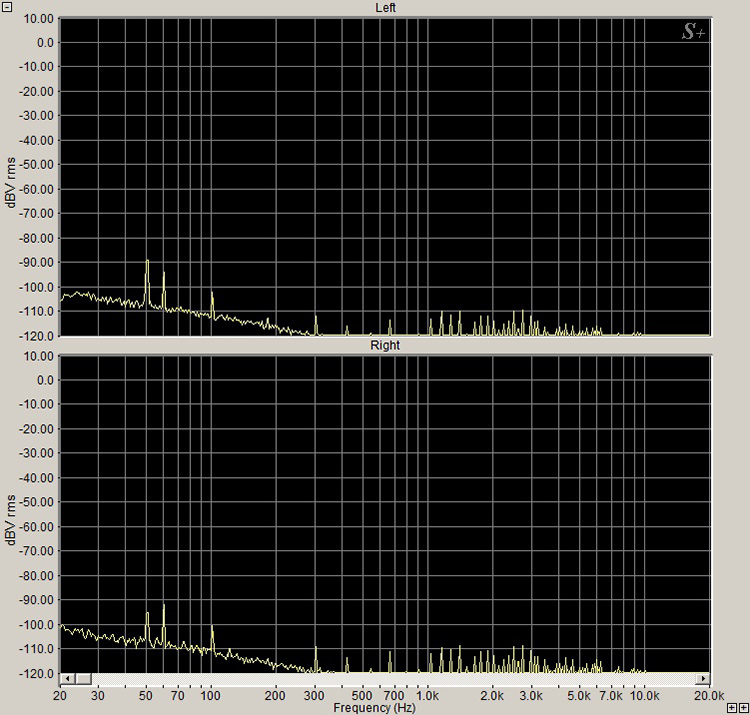
A 1 kHz sine wave test shows THD at 0.67% in the left channel and 0.52% in the right. The largest harmonic is second-ordered, and that is characteristic of vinyl. It gives the listener a warm sound that is very pleasant. The noise peaks have been amplified.
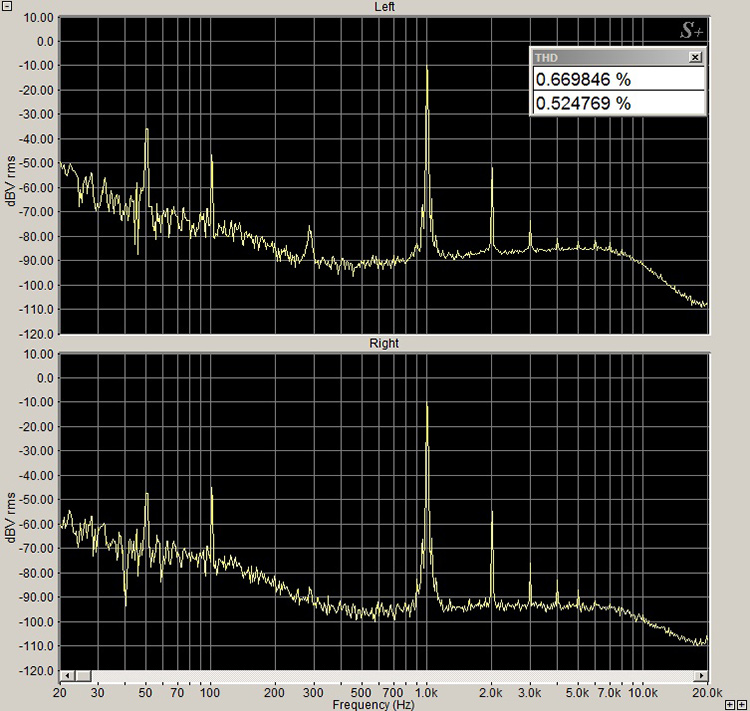
If we zoom in so that we can accurately measure the actual frequency, it is 992 Hz at 33-1/3 RPM. This is an 0.8% error which is more than the spec of ± 0.15%, but it is still not an audible error. The two side peaks next to the 1 kHz peak are probably Intermodulation Distortion (IM) peaks from interaction with one of the large noise peaks at either 50 Hz or 60 Hz.
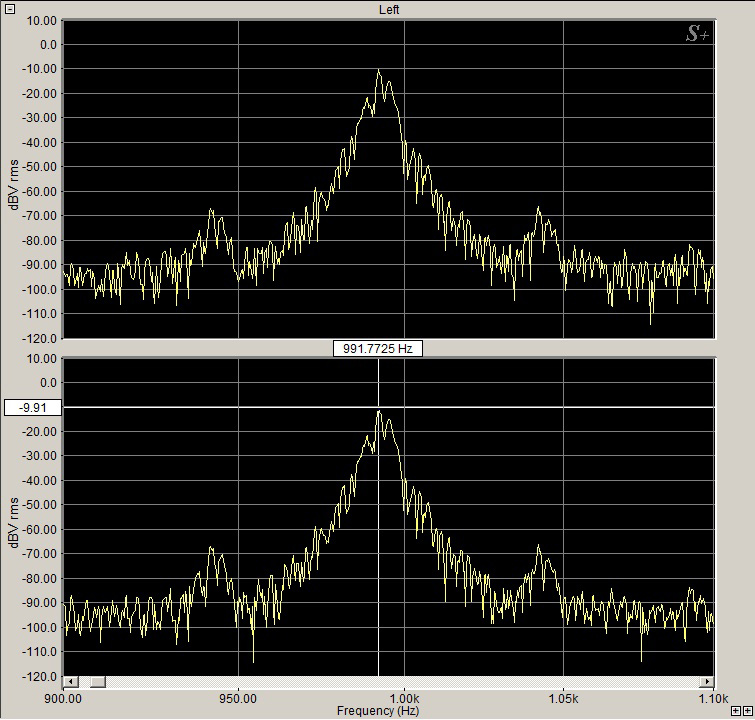
At 45 RPM, a 1 kHz sine wave test track that was recorded at 33-1/3 RPM should be at 1,350 Hz. Here, it is at 1,345 Hz which an 0.37% error. This is larger than the ± 0.13% spec for 45 RPM. Again, though, this is inaudible. A more accurate speed is one of the things that you pay for in more expensive turntables. In some cases, the speed is actually adjustable for both 33-1/3 RPM and 45 RPM.

For a cross-talk measurement, I used a 1 kHz sine wave in the left channel. It read -10 dBV. In the right channel, a cross-talk peak showed up at -45 dBV, which represents 35 dBV difference, so that is the channel separation (35 dBV).

The wow & flutter test result is shown below. A sine wave of 3,150 Hz is used. It displays at 3,124 Hz which, again, shows the speed error. There does not appear to be any flutter. The two side peaks at 3,070 Hz and 3,170 Hz are, in my opinion, Intermodulation Distortion peaks, not flutter.
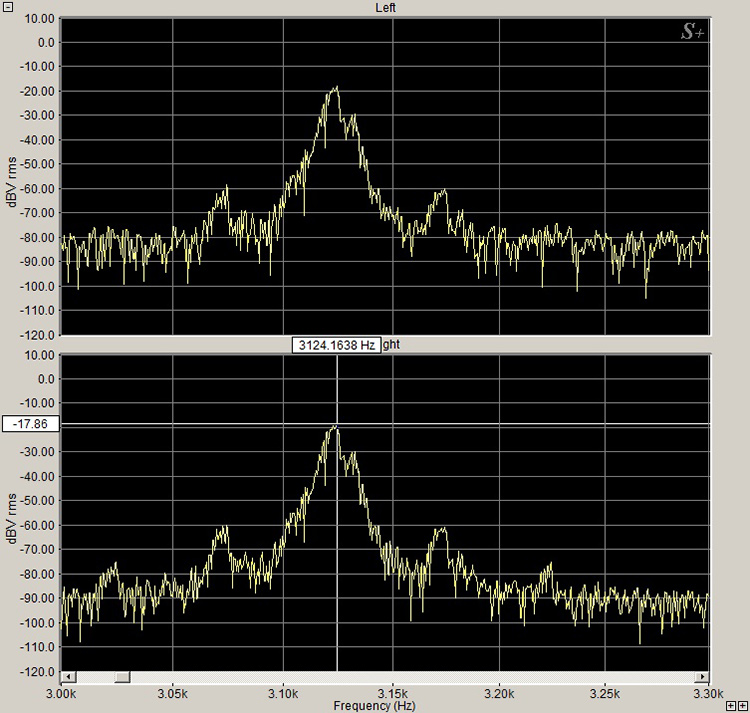
 For a frequency response test, I used a track on a test LP with pink noise. Pink noise, or 1⁄f noise, is a signal or process with a frequency spectrum such that the power spectral density (energy or power per frequency interval) is inversely proportional to the frequency of the signal. It is sometimes used loosely to refer to any noise with a power spectral density of the form where f is frequency, and 0 < α < 2, with exponent α usually close to 1. The canonical case with α = 1 is called pink noise (Baxandall, P. J. (November 1968) “Noise in Transistor Circuits: 1 – Mainly on fundamental noise concepts” (PDF). Wireless World. pp. 388–392).
For a frequency response test, I used a track on a test LP with pink noise. Pink noise, or 1⁄f noise, is a signal or process with a frequency spectrum such that the power spectral density (energy or power per frequency interval) is inversely proportional to the frequency of the signal. It is sometimes used loosely to refer to any noise with a power spectral density of the form where f is frequency, and 0 < α < 2, with exponent α usually close to 1. The canonical case with α = 1 is called pink noise (Baxandall, P. J. (November 1968) “Noise in Transistor Circuits: 1 – Mainly on fundamental noise concepts” (PDF). Wireless World. pp. 388–392).
In pink noise, each octave (halving or doubling in frequency) carries an equal amount of noise energy. There is equal energy in all octaves (or similar log bundles) of frequency. In terms of power at a constant bandwidth, pink noise falls off at 3 dB per octave. At high enough frequencies pink noise is never dominant. (White noise has equal energy per frequency interval.) Pink noise is one of the most common signals in biological systems. The name arises from the pink appearance of visible light with this power spectrum. This is in contrast with white noise which has equal intensity per frequency interval (Wikipedia).
Playing the track with pink noise, you can see below that the slope is smooth out to about 6 kHz at which point the slope increases, suggesting that this particular load, 270 pF, causes a roll-off of the high frequencies above 6 kHz. There is a slight upward swing between 3.5 kHz and 6 kHz. There is also a roll-off below 35 Hz. The 270 pF load is within the factory recommended capacitive load range for the Ortofon 2M Red cartridge. You can adjust the load within that range and listen to the differences in the sound, and just choose the load that gives you the desired effect.
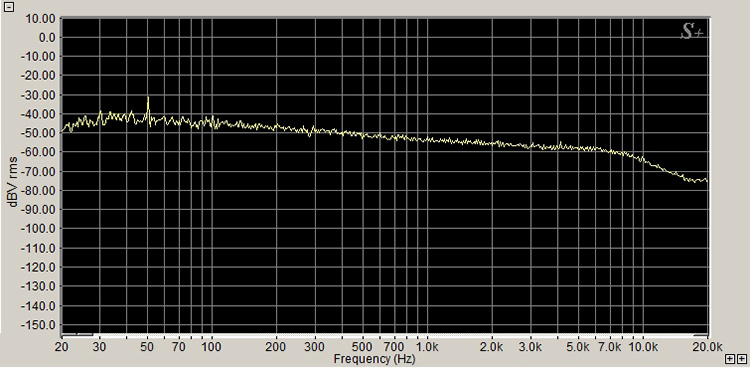
Taking a look at pink noise fed from the sound card’s output back to the input (no turntable in the circuit), you can see the straight spectrum with a constant slope.

The rumble test is shown below. I used a silent groove (groove on the LP with no signal). The principal rumble is at about 13 Hz.
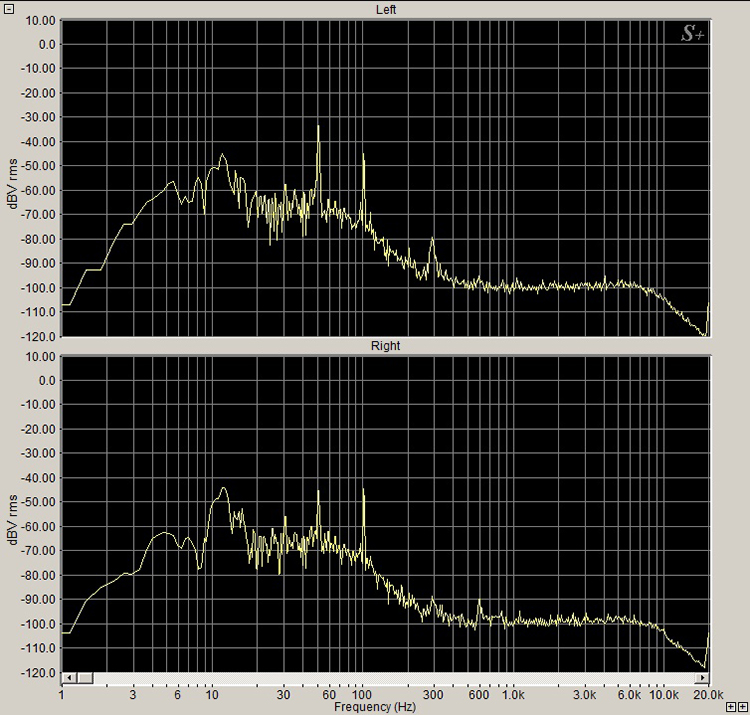
The rumble filter on the phono preamplifier can be used to reduce this, as shown below. The 13 Hz rumble is gone. It did not bother me because my speakers do not respond that low. But it’s probably a good idea to use the filter to reduce the amount of amplifier energy that is otherwise wasted.
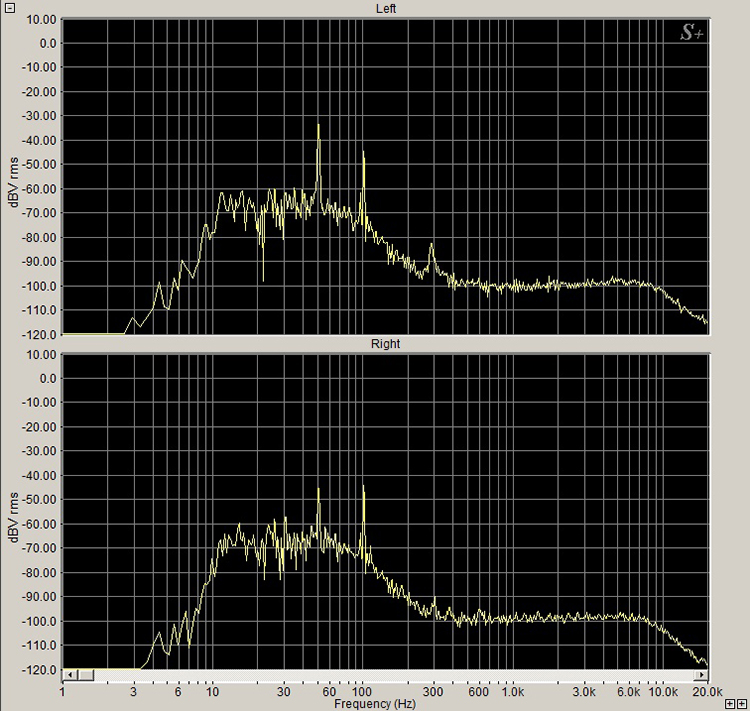
- A good value
- Well built
- Easy to set up
- Rubber platter mat instead of felt
- Extra rubber belt included
The E.A.T. Prelude Turntable is a good value and would make an excellent choice to begin your sojourn into the world of vinyl. You can upgrade to a better phono cartridge later on and enjoy yourself even more.



